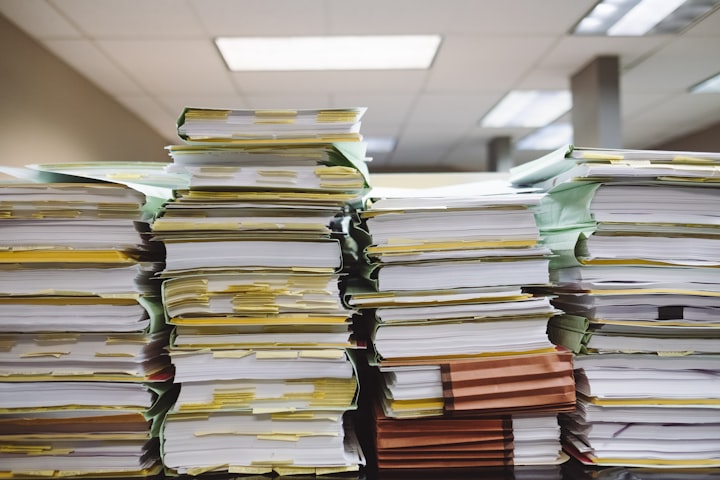Document Control: An Overview
Document control is the practice and technique of enforcing document management rules within a defined scope, such as a workplace. It is the systematic, standardized, and regulated arrangement of documents, data, and information. It is a type of quality control that entails developing and enforcing a set of procedures, control processes, and practices that govern the creation, identification, definition of responsibilities, approval, storage, and protection, distribution, efficacy and release, versioning, periodic review, revision, retention, and disposal of documents within a specific setting.

Table of Content
1. What is Document Control?
The discipline's definition and key concepts
2. The Role of the Document Controller
Tasks of Document Controllers; Description of the role of a Document Controller
3. Document Processes
Typical processes to manage documents: internal documents, project documents; typical interactions between interfaces (authors, Document Controllers, external entities, etc.
4. Checking Documents
What are the Document Control checks on documents, and what should the Document Controller do in the event of a document anomaly?
5. Document Numbering/Referencing
Document numbering and referencing requirements and concepts
6. Revision Control
Difference between revision and version, types of revision systems, introduction to document status
7. Document Register
What is a document register, and its importance?
1. What is Document Control?
Document control is the practice and technique of enforcing document management rules within a defined scope, such as a workplace. It is the systematic, standardized, and regulated arrangement of documents, data, and information. It is a type of quality control that entails developing and enforcing a set of procedures, control processes, and practices that govern the creation, identification, definition of responsibilities, approval, storage, and protection, distribution, efficacy and release, versioning, periodic review, revision, retention, and disposal of documents within a specific setting.
Document control ensures that all information about a certain part of the workplace is accurate and consistent. Document control also ensures that documentation is reliable and accurate.
According to ISO 9001:2015, organizations must maintain control over the documentation necessary by the quality management system. All of ISO 9001:2015's standards are generic, meaning they may be applied to any business, regardless of its size, type, or products and services. This standard states notably that: "A documented controls procedure shall be established to define the controls needed:
• To approve documents for adequacy prior to their issue,
• To review and update documents as needed, and to re-approve documents,
• To ensure that changes and the current revision status of documents are identified,
• To ensure that documents remain legible and readily identifiable.
• To ensure that documents of unknown origin are identified and distributed controlled, and to prevent the unintended use of
• Obsolete documents, and to apply suitable identification to them if they are retained for any purpose."
• To ensure that relevant versions of applicable documents are available at points of use.
Furthermore, records must be kept and controlled as proof of specification compliance and to demonstrate the success of the quality management system's functioning.
The Document Control Values
• Traceability - Strict revision and modification control ensure that all changes can be tracked and audited. Document deliveries must be documented and tracked (e.g. with transmittal sheets). MDRs, Transmittal Registers, and other registers must be kept up to date with accurate information.
• Integrity - If a document is not fit for use, it should not be issued, published, or circulated. It must, for example, be readable and have no missing pages or attachments. Identification information (e.g. document number, title, revision index, revision date, etc.) must be consistent, correct, and adhere to both internal and external rules (e.g. Document Control method). Issuing or disseminating a document that isn't fit for the purpose might have major effects, including safety issues, legal ramifications, and financial costs.
• Compliance & Gatekeeping – Quality checks, formal reviews and comments, approvals for issuance, registration, modification, and revision control are all processes that documents must go through before being issued. Documents with flaws must not be permitted through review gates. Documents must be processed in a controlled manner, and company regulations and procedures must be followed.
• Consistency - is obtained through following protocols, norms, processes, and rules in a methodical manner. Company templates, which are generated and utilized for four purposes, must also be enforced by Document Controllers:
a. To create a visual identity for the business;
b. To ensure that critical metadata or fields (e.g. author, date, revision number, etc.) are filled out;
c. Authors of documents will save time;
d. To ensure that the appearance of documents is consistent.
Maintaining uniformity, and so indirectly protecting the company's reputation, interests, and expenditure, is part of the Document Controller's job.
• The Quality Management System includes Quality-Document Control. In order to produce a consistent product, Document Control must follow a consistent and documented process (in our case, the Document Control service). This emphasizes the need of having defined protocols, guidelines, processes, and norms, without which the quality of the service supplied frequently varies, to the prejudice of clients (project team, engineers, client, partners, etc.).
• Safety - Document Control was created as a separate discipline from engineering to ensure that employees working on-site (construction, operations) could operate safely with up-to-date, checked, formally evaluated, and approved documentation. Document Control methods such as issuing "advance copies," "working copies," non-approved papers, and erroneous or obsolete updates of documents, for example, can put lives in danger on the job site.
2. The Role of the Document Controller
The document control function is in charge of managing document flow and storage in an organization through a variety of activities and processes. A document controller is someone who manages all of an organization's paperwork, whether for a project or for the entire company.
Document Controllers are specialists who support controlled processes and practices to assure document accuracy, validity, and dependability at all stages of their existence in order to reduce risks for the organization and provide users confidence in the company's documents.
The importance of Document Controllers in an organization can be summarized as follows.
• Managing Control-Required Documents (control-required documents) solves the question of what has to be managed fast.
• Reviewing, altering, approving, and re-approving papers: All documents must be evaluated for appropriateness before being used.
• Identifying revision changes and their status: It is necessary to identify revision changes in documents.
• Making documents available in multiple locations – a document is worthless if it can't be found.
• Making documents readable, or able to be read and comprehended, is the first step in making them legible and recognized.
• Managing external documents: An external document is one that is published outside of the organization and is used within the scope of the management system.
• Controlling outdated documents: the simplest and most obvious method of preventing unintended usage is to remove obsolete papers from circulation.
• A few words about forms, which are managed as "attachments" to procedures.
Document Control's purpose is to assist the company in recording the elements that are critical to its operations. Controlling documents is essential for a company's efficiency and growth. Data is delivered at a dizzying speed. It's not enough to just collect and store data; you also need to be able to rapidly search, retrieve, and use it.
An example of common DC tasks
- Allocate a number to documents.
- Archive/Record comments made on documents (internal and external)
- DC Focal point with external entities (Client, Contractor, Sub-Contractor, Vendor, Supplier)
- Document distribution (external recipients)
- Document distribution (internal recipients)
- Electronic document filing
- Document filing in hard copy
- Follow up of review cycles/approval cycles
- Induction of new users to DC rules & processes and/or use of the DC software package
- Management of obsolete/superseded documents
- Official transmittal of documents (using transmittal sheet)
- Quality check documents
- Register documents
- Document status reporting (statistics, KPIs, reports)
3. Document Procedures
Process and Controls Documentation – Internal documents, project documents, and normal interactions between interfaces (authors, document controllers, external entities, etc.) are examples of typical document management processes . It establishes the guidelines for how documents are reviewed, updated, or altered, how changes are tracked, how documents are published (internally or externally), and how documents are decommissioned.
Procedures/processes for document control have a number of advantages.
- A fundamental benefit of document control procedures is that they ensure that the proper, up-to-date, and approved document is used.
- Out-of-date or inaccurate documents can be a huge source of concern, and they're one of the most common audit results in compliance programs.
- Unapproved or obsolete procedures, uncontrolled documents, unavailable or missing files are just a few of the audit findings that may be avoided if document control measures were in place.
The processes outlined by a Document Control Procedures Manual are known as document control procedures. These include:
- Document creation: the document control procedure determines who creates a document and how the document is created.
- Document review and approval: the document control procedure specifies how a document is evaluated, who approves it, and how approvals or revisions are recorded.
- Document modifications: Even after documents are finalized and approved, they frequently require revisions in the future. The process for document modifications will be determined by document control processes.
- Document publishing: once a document is finalized and approved, the document control processes specify how and where it will be published, as well as who will have access to it.
- Document obsoleting: Another key process detailed in the document control technique is document obsoleting, or the removal of documents from availability.
4. Checking Documents
To maintain a high level, it's critical to double-check a document's accuracy. If a document is not thoroughly examined, it may contain errors, rendering it illegible and inappropriate for its intended function.
Proofreading entails thoroughly inspecting your (yet-to-be-finally-printed) content for typographical and grammatical flaws and correcting them. Proofreading your documents indicates that you care about what you publish and that you take pride in your job.
The Importance of Proper Checking of Documents
- Misspelling, punctuation errors, grammar mistakes
- As a means of reducing risk, paragraph flow is erratic.
- Proper references.
- It keeps you prepared.
Follow these guidelines:
- Read your work slowly and loudly, as if you were giving a presentation.
- After you've double-checked the structure of your essay, concentrate on the grammatical problems.
- Begin reading at the conclusion of the essay.
- Pretend you're a new reader looking at your work for the first time.
5. Document Numbering/Referencing
How to Put a Document Control Numbering and Referencing System in Place
Document numbering and referencing is a crucial part of the document management process. It's a method of identifying documents in order to develop, organize, share, and store relevant and vital data. It explains how document reference (identifying) numbers are generated and seeks to persuade document owners to correctly name their files and documents. As a result, any organization must learn how to develop and implement a document management system.
Implementation of the Document Control Numbering System
- To make it easier to find, reference numbers are assigned.
- The DCO keeps track of the reference numbers for letters issued by the Head Office. A distinct reference number is kept by the workshop department.
- If appropriate, internal correspondence reference numbers are accessible and maintained by the offices of each Department Head and Section Head.
- Project Managers or Project-In-Charge officials keep track of reference numbers at project sites.
- The letters and numerals on the project site must be consistent. It must be done in accordance with the project, not on the basis of who signed or wrote the letter.
6. Revision Control
The relevance of document version control derives from the fact that most papers undergo numerous revisions and edits, particularly digital documents with difficult-to-track alterations. It's vital that the user knows which version of the document he's looking at, whether it's for a project or a corporation. Also, if the document's versions are controlled using an appropriate policy, it will be easier to handle in projects where a number of team members are contributing to the development of a collaborative document, which may have to go through a number of modifications before being finalized. Any document's revision is appropriately identified (audit trail). To ensure that any modifications are clearly documented and time/date stamped, as well as the identification of the person responsible for the revision, a revision audit trail is required.
Document Version Control Policy
A document version control policy should ideally be in place before the project begins. There must be only one version of the document in use at all times during the project's execution. When the document is amended or revised, the revised version of the document must be made available to all team members.
Every document must state clearly which team members are permitted to alter the document's contents and to what extent. In addition, the document must include a location to record information about the alterations, such as the person's name, the version code, and the date of the edits. Every version of each document must travel through this person. As much as practicable, a team member who will be responsible for handling papers must be designated. Following this procedure will ensure that all members of the team have access to the most recent version of the document.
Both physical and digital documents must be covered by the document version control policy.
A distinct version coding system must be established and conveyed to all team members involved in document creation, editing, review, or revision. When submitting the modified or revised versions, they must all explicitly indicate how the version code must be changed. It is preferable to utilize the coding in the document's header or footer.
The relevant versions of documents are available for retrieval. At any stage during the change cycle, all relevant workers should be able to locate and obtain a document version. Changes to the document should also be communicated to appropriate workers. A document's lifecycle includes changes to it. The document version control policy of a controlled copy must be explicitly defined in the document control method.
It just needs to figure out who has the authority to edit the document. It must follow best practices for version control numbers. An approval process is usually necessary when changes are made and for particular documents. The document control mechanism should have built an approval hierarchy depending on document type.
Document revision control is regarded critical, and document controllers must keep a tight eye on what is being altered and who is making the changes. You'll get a report on document modifications, a comparison of what's changed in a matter of seconds, and version control in documents if you use a system.
7. Document Register
The Master Document Register (MDR) is a database that keeps track of all the documents. This method covers tasks like receiving incoming and outgoing papers, classifying, documenting, and delivering them to the appropriate recipients, as well as filing.
This involves tasks such as sorting incoming and outgoing documents as well as guaranteeing a timely response.
This process starts with sorting and ends with storing or filing incoming and exiting documents. The MDR is essentially a list of all of a project's documentation deliverables, together with supplementary information about each of these papers, such as:
- Information on identification (number, title, reference, document type, etc.)
- Information about the status and progress of the project is documented (revision index, date, status, etc.)
- Dates of delivery, both expected and actual
- To keep track of the project's development and detect any potential issues as soon as feasible
- The MDR is an important tool for both the Document Control team and the Project Management and Project Controls/Services team in general. Late contractor documents, late client comments, lost documents, potential delays with deliverables, and thus the impact on the project timeline, as well as any other documentation-related concerns, can all be identified using data from the MDR. It is also a document that is utilized during project progress meetings (both internal and client/contractor meetings) to track and ensure the progress of documents.
- It is one of the most important documents on a project, and while Document Controllers maintain it, it contains information that is relevant to many other fields.
This is why it is also excellent practice to agree on the template, format, and frequency of issue of this crucial document from the start of the project. To ensure that received and transmitted documents are properly identified, accurate, and traceable. To ensure that documents are delivered on time to their intended recipients. To create a more efficient and effective method of recording incoming and outbound communications.
Do you like what you read?
Don't forget to please like my story.
Thank you.
About the Creator
Domingo Añasco-Gaces Samontina, Jr.
.Professional Member of the Mechatronics and Robotics Society of the Philippines
.Certified Documented Information Controller with TUV Rheinland Qualifications
.Master of Science in Engineering (on-going) with Professional Teacher Certificate






Comments (1)
cool